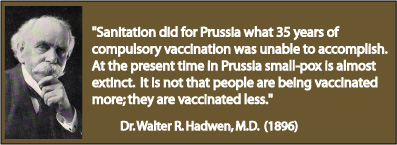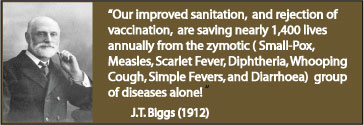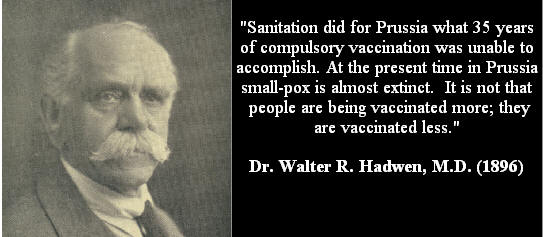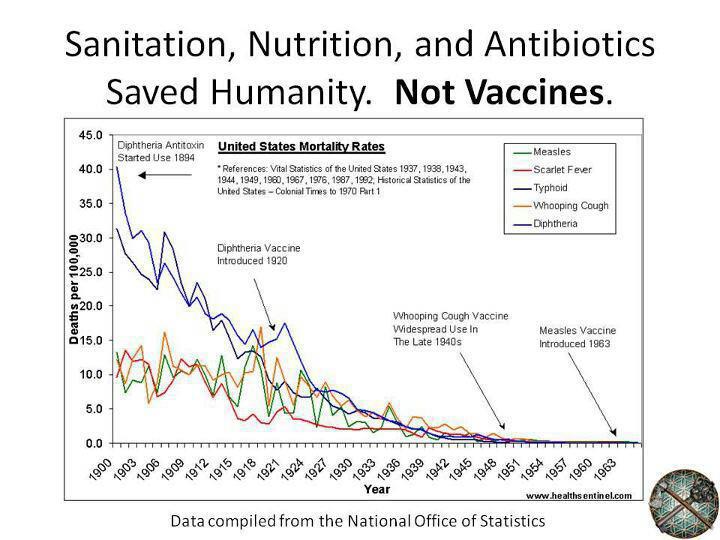 Leicester
Ignaz Semmelweis
Leicester
Ignaz SemmelweisSanitation vs. Vaccination
Disease theory
Smallpox
[back] Poverty
About 1.2 billion people still have no access to safe drinking water, and 2.4 billion do not have adequate sanitation services. Some 2 million children die every year from water-related diseases. (Ref)
"Sewers introduced into Leicester, 1851. Sewer ventilation introduced,1881." LEICESTER: SANITATION versus VACCINATION BY J.T. BIGGS J.P.
See:
Poverty
Nutrition & infection
quotes Leicester
Ignaz Semmelweis
Leicester
Ignaz Semmelweis
Quotes
Leicester quotes
Sanitation vs. Vaccination quotes
"The Leicester Method" by
J.T. Biggs quotes
Book extract
[1898] A Century of Vaccination and What it Teaches by W. Scott Tebb
CHAPTER 3. Some of the Causes of the
Decline in the Small-pox Mortality
Articles
[2009 June] Village boycotts polio campaign to
protest civic conditions Residents of Sarvat village in the
Muzaffarnagar district, about 350 km from Lucknow, boycotted the vaccination
drive May 24 and said they will continue their protest till their complaints
about poor sanitation, contaminated water supply, and lack of garbage disposal
facilities are addressed.....“Go to any place around the village, you will
surely find filth and squalor… clogged drains that have become breeding ground
for mosquitoes and other insects,”.....With no garbage disposal system,
residents are left with no option than to throw the domestic waste onto the
roads. “In most of the village, you will not find any garbage bins, due to which
the waste here is thrown out in the open"
A Framework for Action on Water and
Sanitation
[2002 Bangladesh] Basic Sanitation
[1881] SANITATION, NOT VACCINATION THE TRUE Protection against Small-Pox By WILLIAM TEBB.:
Dr William Collins: paper read before
Sanitary Committee of St Pancreas 1863
Smallpox death rate by Dr Shelton DC



[2002 Bangladesh] Basic Sanitation



A "Cow Keeper" provided fresh milk. Conditions in the store, however, were
highly unsanitary. Cows were kept inside the store front. Cow waste was thrown
into the street at the end of the day. ( www.j-sainsbury.co.uk/museum/ media/
)
http://cai.ucdavis.edu/waters-sites/sanitation/

LONDON’S DESTITUTE SANITATION CONDITIONS. Nineteenth century London
reflected the age of the Industrial Revolution. New buildings and sizeable
developments attributed to the overcrowded slums as the population growth surged
from one million in 1800 to six million by the dawning of the twentieth
century. This notable increase in the population was reflected by the city’s
increased sanitation needs. Problems such as overflowing drains, sewage leaking
through defective pipes, and decaying animal and human excrement attributed to
the sanitation dilemma. In addition, sewage gasses were emitted through toilets,
baths, and sinks into the dwellings of London’s inhabitants.
Such destitute sanitation conditions, as well as the
employment of coal-fired stoves, produced heavy and foul-smelling air in and
around the city. Wastes and other fecal matter plagued the environment and its
inhabitants due to the unavailability of proper disposal means. Tons of raw
sewage, both from the city itself and by the neighboring valleys, was dumped
straight into the Thames River and eventually carried up the river by the tide.
Sanitation conditions were abhorrent during Victorian London.
The public suffered severely from epidemics that included
three massive contagious diseases: cholera, typhus and influenza. These
infectious diseases were often fatal or left its victim weakened in their
defense against other diseases. The main cause of these illnesses was attributed
to the poor sanitation conditions such as an overcrowding workforce,
contaminated water, and unpaved streets with ankle deep mud. Many families
ravaged by fever died due to poor public health. It was estimated that in 1839,
for every person who died of old age or violence, eight died of specific disease
caused by the sanitation. Source:
http://cai.ucdavis.edu/waters-sites/sanitation/
https://itwassanitationnotvaccinesstupid.wordpress.com/2016/01/31/londons-destitute-sanitation-conditions/

TRASH PILED UP ON VARICK STREET IN NEW YORK (1893) BEFORE SANITATION REFORM.
By the nineteenth century, New York City was persistently and famously filthy.
While other urban centers had begun to clean up their streets, approaching
vessels could still smell New York far out to sea. Yet, the Department of
Sanitation (DSNY) was founded in 1881 as the Department of Street Cleaning and
became one of the first sanitation agencies in the world that democratically
cleaned and picked up snow from every street, regardless of socioeconomic class
or neighborhood. One of the Department’s first Commissioners, Colonel George E.
Waring, Jr., pioneered such current practices as recycling, street sweeping, and
a dedicated uniformed cleaning and collection force called the White Wings.
https://itwassanitationnotvaccinesstupid.wordpress.com/2016/01/31/trash-piled-up-on-varick-street-in-new-york-1893-before-sanitation-reform/

THE GREAT HORSE MANURE CRISIS OF 1894. It was entitled ‘The Great
Horse Manure Crisis of 1894’ and it explained how innovation in a free
marketplace solved the problem urban planners of that day said was unsolvable.
You see, in the 1890’s horses were the primary means of moving things around,
including people, and as the cities grew the number of horses grew. It was
estimated that New York City had 100,000 horses producing 2.5-million pounds of
horse manure every day, and they couldn’t just let it pile up.
https://itwassanitationnotvaccinesstupid.wordpress.com/2016/01/31/the-great-horse-manure-crisis-of-1894/

IN NEW YORK, NOT UNCOMMON FOR DEAD ANIMALS TO LIE ON THE STREETS FOR WEEKS.
The sanitation department in New York was created as the Department of Street
Cleaning in 1881, and renamed the Department of Sanitation in 1929. But it was
actually made effective for the first time in 1895, in that the people who
worked for the department actually collected garbage and swept the streets. In
its early days, the department didn’t really function at all. There are some
photographs taken for Harper’s Weekly, before and after photos of street
corners in New York in 1893 and then in 1895. And the before pictures are pretty
astonishing, people were literally shin-high or knee-high in this muck that was
a combination of street gunk, horse urine and manure, dead animals, food waste,
and furniture crap.
https://itwassanitationnotvaccinesstupid.wordpress.com